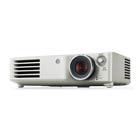
Projectors are a common feature of the business landscape, and they easily and effectively allow the dissemination of information in a group setting. Small offices can benefit from having a projector handy for meetings and presentations, and for large companies they are invaluable. When you need to get your message out, using a projector eliminates the need for cumbersome and costly handouts and outperforms mass emails. Projectors are also seeing increased use in the home, as the focus of home theater-style entertainment systems. Whether it's for home or office, a projector might just be the thing you are looking for.
Contents
Native Resolution/Display Size: These measurements determine the size of the displayed image. The standard for smaller projectors is 800x600, which is appropriate for smaller presentations. 1024x768 and 1280x800 projectors are mid-range performers, perfect for larger gatherings in a sizable room. Anything larger is a top-end projector that will be able to create a huge image, a necessity for extra large presentations in concert halls, large auditoriums, and convention settings.
Aspect Ratio – 4:3 is the standard for most projectors, however many of the newer, more advanced models are capable of 16:9 or 16:10 wide screen ratios. If you plan on projecting television or film content, or even full motion video business presentations, a projector that can accommodate wide screen format is a necessity.
Brightness – Brightness determines the clarity and distinctness of the projected image, and is especially important for larger models intended for bigger groups. Brightness is measured in lumens – the more lumens, the brighter the image and the more flexibility you will have in catering to large groups.
Make sure you can connect properly with the projector you intend to buy. Most projectors offer S-Video, analog RGB, and composite cable connectivity. For added ease of connectivity, look for a projector that has USB port hookups.
Almost all projectors come with two watt speakers standard. These are rather small, and you may wish to augment audio output with additional speakers. Fan noise may be a related consideration, particularly with small projectors meant for intimate settings. For all but the smallest venues, extra speakers are recommended.
If you are having a hard time deciding between different models, make sure you check out any extras offered by the manufacturer. Two year warranties are common, but some manufacturers offer them for three years. A remote control might be a nice convenience – check to see which models have them. Some manufacturers may even offer an additional free bulb with your initial purchase. When it is hard to choose based simply on performance, look for the little extras that might make a difference.
Acer has created a line of cost-effective projectors that complement their low-cost computers – their performance is more than adequate if you don't need any fancy extras. NEC, InFocus, and Panasonic all offer several models, and have something for small gatherings or large presentations. Epson has distinguished itself with its high-end models that are best in large venues – if you have an extra large group, chances are you'll need an Epson.
 alaTest USA
alaTest USA alaTest UK
alaTest UK alaTest Deutschland
alaTest Deutschland alaTest France
alaTest France alaTest Italia
alaTest Italia alaTest España
alaTest España





 Drive sales with reviews on your site
Learn more about our B2B solutions
Drive sales with reviews on your site
Learn more about our B2B solutions